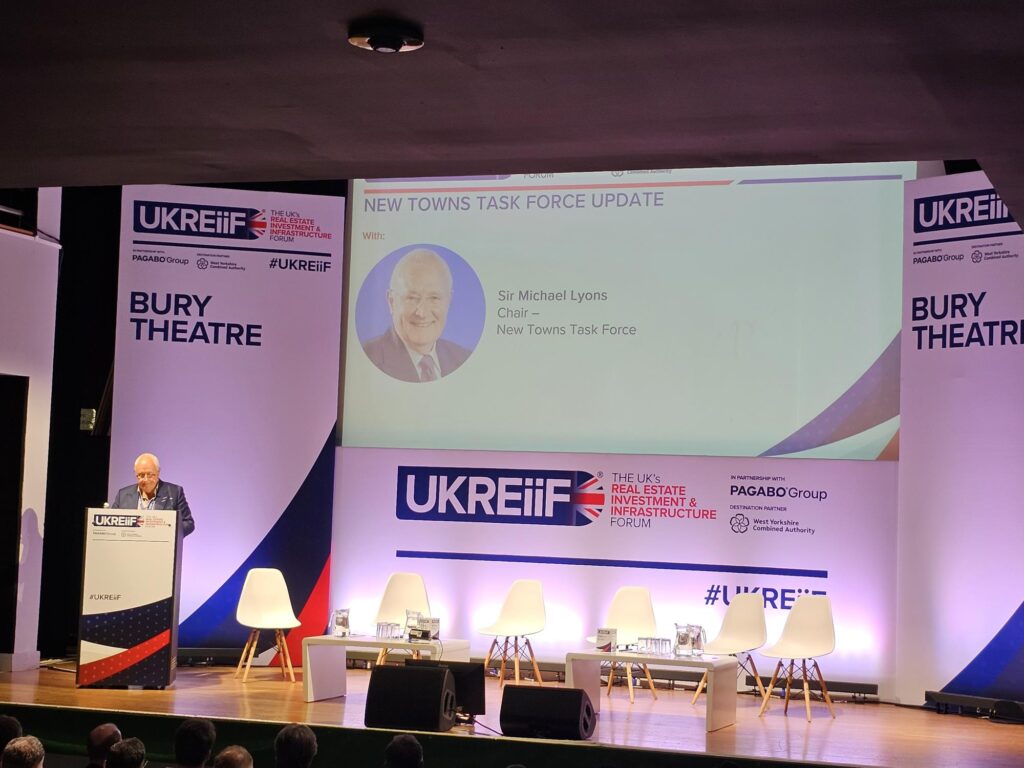The inside scoop from The Secret Delegate at UKREiiF
What if you could eavesdrop on the juiciest UKREiiF deals in the making? I am The Secret Delegate, the shadow with go anywhere access. And I’ll be bringing you those critical high-level conversations unshackled.

Summary
-
- Burnham, Transport, and HS2
- Toby Reid, and start-up investment
-
- The £24bn Bet, to Build the UK’s Future
-
- British Land Gets Planning Consent
-
- Green Energy in 2050
-
- Local Investment Confusion
-
- New Towns Taskforce Update
-
- Rayner’s Update on Labour’s Housing Target
-
- The Great North Launch – a new chapter for regional growth.
-
- Looking for belief at UKREiiF
-
- £50bn pension fund infrastructure boost
-
- Ebbsfleet – the starting gun
- £6.5bn East Anglia Three
UKREiif 2025 Wrapped
30 May 2025

The Secret Delegate
The UKREiiF sleuth with anywhere access, uncovering the stories you won't find anywhere else.
Greater Manchester Mayor, Andy Burnham, had a few choice words for HS2...
22 May 2025
Greater Manchester’s mayor, Andy Burnham, came out swinging at the Treasury during UKREiiF day two.
He said:
“With three weeks to go to the Spending Review, funding for transport is funding for growth. It’s pretty simple. Actually, cutting transport is choking growth, and that needs to be understood because we are the fastest growing city region in the country.
“We’ve had average annual growth of 3.1% over the last decade. If you’ve got growth at that level, you have to get ahead and build out the infrastructure to support a growing city region. If you don’t, the growth can quickly lead to congestion and frustration.”
He wasn’t done there, not by a stretch, and aimed haymakers at HS2. Can’t say I blame him.
“The country needs to be honest with itself about the disaster that was HS2,” he growled. “And the bias that the south can have whatever it wants, and bats get palaces [on the route], and people don’t have to look at ugly rail infrastructure [with much of it in tunnels], but people in the north have to.”
“It goes to the heart of the unfair way in which the country has been run. And if they let HS2 trains roll north from London to the Midlands and then come on the creaking West Coast Mainline [to Manchester], that will be a living monument and a permanent national embarrassment.”
Phew…

Investing in top-tier brains in the UK
22 May 2025
Developer Pioneer Group’s exec director, Toby Reid, reckons brilliant UK start-ups with top-tier brains get snapped up before they stand a chance.
An outfit with 25 PHDs will vanish into a corporate black hole — no fanfare, no legacy.
Reid explains:
“We need companies scaling to 100, 200, 300 people — adding lab techs, marketing, finance, admin, the whole engine. That’s how you build real economic muscle.”
He said right now, the window’s wide open. The science talent is here, it’s world-class. But we need to quit playing small. Time to move faster, go bolder, and most of all back these ventures with serious money — before our best ideas become someone else’s profits and we’re left wondering what could’ve been.

Quit Playing Small: The £24bn Bet to Build the UK’s Future
22 May 2025
The The Crown Estate’s £24bn deal to get into bed with Lendlease for six transformational projects got airtime from top honcho Dan Labbad.
It’s public money, so the return goes back to taxpayers — no room for mistakes. A fresh Act of Parliament expanded Crown Estate’s powers to invest and to borrow, laying the groundwork.
Without that push, the deal wouldn’t exist. This isn’t just business — it’s national strategy. Years of asking why the Crown Estate exists led here: driving investment where the UK needs it — housing, renewables, life sciences.
“We’re here to serve the nation,” Dan says.

British Land Gets Planning Consent & MP George Freeman
21 May 2025
Heard a whisper that British Land got planning consent last night for a new innovation and/or life science scheme in Oxford.
Didn’t even require a shakedown.
Those at the sharp end of delivering such schemes might want to have a word.
Also on the wind…
An informant told me MP for Mid Norfolk George Freeman was heard advocating muscular devolution where any reduction of current Treasury-managed deficits would see mayors keeping half the saving. Or keeping half of any betterment of growth targets.
Reckons you’d quickly see a number of leaders step up to run other clusters too — including himself in East Anglia.
Said if there was to be a mayor for Cambridge North and Suffolk, he’d probably stand because properly knowing the ground means “you could really do something”.
What Will Green Energy Look Like in 2050?
21 May 2025
Tom Hayes MP Government Mission Champion for Energy and MP for Bournemouth East suggested nuclear power will play a significant role in the 2050 energy mix.
He advocated for not just completing Sizewell C, but also developing small modular reactors (SMRs) and advanced modular reactors (AMRs) simultaneously.
He added that the government aims to support nuclear development in strategic locations like the Dorset supercluster, which will include SMRs alongside solar, offshore wind, and carbon capture and storage.
The previous government’s target was 24GW of nuclear capacity by 2050, and Hayes said the current government appears to be maintaining that trajectory.
Nuclear is seen as a complementary technology that can help unlock the data centre revolution and provide energy security through decentralised power generation.
Hayes also referred to the skills shortage plaguing construction.
“I was at a dinner last night with a defence contractor, who was saying they can’t get the welders into their business, because Hinkley Point C can pay double the amount.
“It just speaks to a shortage of the trades that we need to actually build the things that we need to decarbonise, to be secure and to build the homes that will actually house our communities.”

"Who do I speak to?" Lord Harrington Highlights UK's Local Investment Confusion
21 May 2025
A thought-provoking anecdote from Lord Richard Harrington, author of ‘The Harrington Review of Foreign Direct Investment’, where he described a national hurdle when a German company representative wanted to invest in Yeovil.
“He said ‘Richard, who do I speak to? Is it the leader of Yeovil Council? Is it the mayor of Yeovil? Is it the MP for Yeovil? Is it Cornwall Council?’ There’s no entity in many places that foreign investors can look to.”
He said in Germany, there’s basically a number that everyone knows in each state.
I said, “Yeah, that’s because in 1952 we imposed a constitution on you, which had we done it on ourselves, we’d be a lot better off from a foreign direct investment point of view.”
I mean, it’s an amusing story, but it’s actually true. The mayoralties, to many people, are the only entity [for this], and they’re really good like that. But the other areas have to strengthen themselves in clusters. I don’t care about the politics of it, there has to be one very strong entity.

New Towns Task Force
21 May 2025
In an update on the New Towns Task Force, chair Sir Michael Lyons emphasised that future new towns must be more than just housing developments.
Instead, they should integrate infrastructure, economic growth, and placemaking from the outset. Each town is expected to include at least 10,000 homes, with strong commitments to affordability, environmental resilience, and long-term viability.
A shortlist of specific sites is being prepared with named partners for early start schemes. Sir Michael said the findings will not be limited to standalone new towns and include urban extensions and regenerations.
He noted challenges include high upfront costs for infrastructure and master planning, the risk of diluted quality due to market pressure, the need to ensure cross-departmental government alignment and a requirement to balance bold vision with fiscal realism.
Final recommendations are expected within two months, with a focus on deliverability and early wins.

Rayner's Update on Labour's Controversial Housing Target
21 May 2025
Deputy Prime Minister Angela Rayner dutifully toed the government’s often challenged line on its ambition to see 1.5 million homes built this Parliament.
She highlighted £800 million in top-up investment in social housing as well as a £2 billion top-up funding next year, with more to come at the Spending Review, and re-emphasised efforts in planning reform and investment in construction skills.
Key measures include unlocking land, empowering mayors, and £3bn of support for smaller builders. She stressed partnership between government, investors, and local leaders, citing regional successes in Yorkshire and beyond.
Urging action across the sector, she invoked post-war ambition to deliver lasting growth, opportunity, and stability for working people.

The Great North Launch at UKREiiF: A New Chapter for Regional Collaboration and Growth
19 May 2025
UKREiiF kicked off on Monday with an unprecedented gathering of eight northern mayors and Deputy PM Angela Rayner formally launching The Great North — a new cross-regional partnership aimed at driving investment, accelerating devolution, and highlighting the North’s role in shaping the UK’s future economy.
The initiative brings together metro mayors, business leaders, and government representatives to present a united front on shared priorities such as clean energy, advanced manufacturing, creative industries, transport infrastructure, and skills development.
The partnership is designed to attract investment, create jobs, and boost regional economic resilience, with a strong emphasis on place-based leadership and local decision-making.
Key themes included:
- A £180bn investment opportunity across the North
- 50% of England’s renewable energy being generated in Northern regions
- Collaborative efforts to strengthen creative and cultural industries
- A shared commitment to modernising transport and rural infrastructure
- Northern Investment Summit in 2026
Speakers emphasised that the North’s potential lies in its people, industrial legacy, and growing global profile — but that fully unlocking this potential will require deeper devolution and sustained public-private cooperation.
The Great North brand, originating from the legacy of the Great North Run, will now be used to champion these ambitions and communicate a clear, cohesive identity for the region at home and abroad.
This event marked a significant milestone in inter-regional collaboration, with a focus on solutions led by those closest to the communities they serve.
For those interested in regional development, clean growth, and economic transformation, The Great North offers an emerging model of how locally driven strategies can align with national priorities.

Looking for Belief at UKREiiF
16 May 2025
With a hungry industry hitting UKREiiF next week, here’s a top-down market snapshot.
It’s an 11th hour recap of where the action could be and where the bottlenecks are. It’s a sketch in silhouette of opportunities and hurdles; an illustration of why we need events like this to get the players talking — to make the handshakes happen.
They call it a pipeline, and on paper, it’s a goldmine. Last year’s government commitment to the nation’s infrastructure looked rosy at over £700 billion in planned projects over the next decade. Energy, water, transport, health, housing. The kind of numbers that make investors perk up and planners start drawing maps. But the boots on the ground? They’ve seen this show before. Too much of that cash never leaves the spreadsheet.
Water & Energy Sectors
On the face of it, water and energy sectors are on the cusp of transformation, with regulators pushing for private capital to plug the gap. But big questions remain. Like the direct procurement for customers (DPC) model in water that Ofwat believes offers greater value by increasing competition if water companies competitively tender for services.
Then there’s regulated asset base (RAB) in nuclear where the user pays. They’re both unproven concepts that leave contractors and funders twitchy. No one’s keen to see concrete poured without knowing if the supply chain and revenue stream holds up.
Health & Education Sectors
Meanwhile health and education builds are simmering if not on a rolling boil — smaller, local, more manageable. But even there, pipelines remain murky. Contractors can’t scale their workforce without clarity. Apprentices aren’t trained on hypotheticals. And investors won’t back modular factories if the next five jobs are still stuck in Westminster’s inbox.
Affected Business Types
Contractors feel it first. They’re pricing jobs they know might never land. “We’re in the frame,” they’re told — but weeks drag into months. A contractor can’t build on government ambition alone — they need certainty, continuity, and inked contracts.
For investors, the opportunity is real — but so is the risk. Green energy’s a hot ticket with offshore wind, carbon capture, battery storage — but timelines are foggy, approvals are political, and specialist supply chains are stretched thin.
Projects don’t stall because the money’s missing. They stall because the system’s jammed up. Grid connections are backlogged, planning consent is glacial, and local pushback on new infrastructure is fierce.
The Industry in the Wings
So the industry waits. Ready, but wary. The capital’s there. The talent’s there. The event in Leeds is there. But until someone hands out a clear map with real deadlines, all we’ve got is an engine revving — waiting for the handbrake to come off to drive the market forward.
With go anywhere access, I’ll be listening out for those conversations and bringing them to you here.

£50bn Pension Fund Infrastructure Boost
13 May 2025
It’s a new move in the old city: seventeen of Britain’s pension giants signed on to the Mansion House Accord — a pact with a £50bn promise. The game? Channel long-term pension money into private markets, with a heavy lean toward infrastructure right here in the UK.
These aren’t bit-players either. Names like Aviva, M&G, Phoenix Group and Legal & General are betting 10% of their default defined contribution pension pots on private assets by 2030. Half of that — a cool £25bn — is aimed straight at British soil.
It’ll include clean energy projects, transport upgrades, affordable housing. The kind of gritty, steel, cement and bricks stuff that underpins economies and lines investor pockets — if the deals are sharp.
It’s a step change from last year’s Mansion House Compact, which only flirted with 5% and didn’t care where the cash landed.
The Treasury’s banking on it. With London’s stock exchange losing marquee listings to New York and Frankfurt, the government’s chasing a homegrown revival. Infrastructure is the horse they’re backing — solid, scalable, and built to last.
Chancellor Rachel Reeves called it “a bold step” to unlock capital for major infrastructure, with some start-ups getting in on the action too.
Do the figures stack up?
But hang on, the portfolios of the 17 funds amount to £252bn, and the trumpeted 5% of that aimed at domestic shores isn’t £25bn, so what gives?
Well, the Treasury’s betting on those portfolios gaining around 17% each year, meaning £740bn by 2030, which would mean about £50bn for private market investments.
But not everyone’s raising a glass. Pension bosses are wary. They’ve got a duty to chase the best returns, and patriotic investing doesn’t always pay. If the government starts leaning too hard — say, with future legislation like the pensions bill forcing investments into UK assets — the wheels could come off, along with the gloves.
Still, the market’s moving. Operational reforms, lighter regulation, and access to diverse types of private assets (courtesy of groups like the British Business Bank) are greasing the wheels. Some players, like NOW Pensions, are already lining up housing deals. Others will want a clearer vision on projects and returns before they jump.
For now, it’s a voluntary pact, but with billions on the line the roads, rails, and windfarms will need to deliver not just vehicles, passengers and energy, but the kind of market returns you can bite down on.
With UKREiiF just around the corner, I might have to stakeout the UK Government & Delancey roundtable – Unlocking Growth Via Pension Capital, gather thoughts on the Accord and come back to you.
'New Town' Construction Starting Gun
6 May 2025
It’s rising from the ashes of brownfield waste — 2,500 acres of old dirt getting a second shot at life on the Kent Thames. They call it Ebbsfleet, a shiny new “Garden City”, first of its kind in a hundred years. Just twenty minutes from central London, it’s the edge-of-town dream: where suits, families, and café crooners can all stake a claim.
View the Ebbsfleet Garden City Masterplan on the Barbour ABI Project Leads Platform here.
Right at the heart of this operation sits Ebbsfleet Central — ground zero for ambition. It’ll orbit the international rail station like a planet of steel, glass, and mixed-use intent. Offices, green space, apartments, bars, supermarkets — everything a modern operator needs, wrapped in the slick packaging of wellness and culture.
That’s what they’re selling it as anyway. Phase One will come out of the blocks with 2,100 homes, 100,000 square metres of office space, 10,000 for retail.
Ebbsfleet Central Phase 1 Infrastructure Works
Now the brass is calling for muscle. Contractors and canny knowhow. The Ebbsfleet Central Phase 1 Infrastructure Works contract is up for grabs. We’re talking highways, utilities, structures, landscaping — the bones of the beast. They’re splitting it into Lots, offering the chance to take a slice or the whole pie.
No contracts yet—this is pre-game. An Early Market Engagement Notice (EMEN) drops May 19, 2025. No strings. Just a call to those with the grit to build a vision. They’re hosting a webinar on 3rd June, online, high noon — well, 10:30 to be exact. If you want in, register by 23rd May.
Behind it all is the Ebbsfleet Development Corporation, a government-backed outfit with a mission: 15,000 homes, 50 parks, jobs for thousands, and a transit system to keep the whole engine humming.
It’s the future, laid out in blueprints and ambition. And it’s coming fast. Question is — who’s got the guts to build it?
On-topic sessions worth a snoop at UKREiiF include:
- New towns taskforce update
- New towns, old challenges – can they be delivered?
- How to rebuild a town centre – the opportunities and challenges of PPPs vs capital investment
- London investor & developer brunch

Green Monster Sighted off East Anglia Coast
29 April 2025
Out in the cold chop of the North Sea, ScottishPower just dropped a steel behemoth.
They call it a monopile, but at 1,800 tonnes, it’s more like a battering ram for a cleaner future. It’s the first shot fired for the £4bn East Anglia Three, the biggest offshore wind farm ScottishPower’s ever dared come up with. At 84m tall, and 10.6m in diameter, it’s as long as a sports field and wider than an ecologist’s dream.
View the East Anglia Three Offshore Windfarm Project on the Barbour ABI Platform here.
The Seaway7 crew of the jack-up installation vessel will put down 95 of these giants to anchor Siemens Gamesa turbines — monsters themselves, collectively packing 1.4GW of clean muscle. When they spin, they’ll juice up 1.3 million homes without burning a whiff of gas.
But this was more than a power play, it’s part of £6.5 billion shot across the bow of fossil fuels. ScottishPower’s East Anglia Hub isn’t just a wind farm — it’s a trilogy: East Anglia One North, Two, and Three, aim to deliver around 3GW, slicing a hefty chunk off the UK’s carbon tab.
That’s enough clean power to keep 3.8 million homes out of the dark. They’re not just slapping up turbines; they’re building howitzers in the war against carbon. And in the process creating up to 7,000 jobs, turning coastal towns into bustling centres of renewable energy generation.
Manufactured by Joint Venture Navantia Seanergies Windar Renovables, the first monopile hit bottom in April. By 2026, Scottish Power plans to have the whole fleet humming. It’s a poker move for a greener tomorrow, and they’ve gone all in.
In which case, reckon I might check out the May 22nd UKREiiF session: ‘Making The Most Of The UK’s Natural Energy Resources’.
See which way the wind’s blowing…

Becky Wood & Newly Appointed NISTA
23 April 2025
Becky Wood is stepping into one of the toughest roles in UK infrastructure — CEO of the newly formed National Infrastructure and Service Transformation Authority (NISTA), a heavyweight agency built from the remnants of IPA and NIC.
The government says it’s about fixing the system from the ground up. But with a 10-year strategy looming and high expectations from Whitehall, the real question is: can NISTA deliver where others have failed?
In my blog for Barbour ABI, I explore:
- What NISTA is really set up to do
- Why Becky Wood’s appointment matters
- The risks of centralising too much power
- And whether this marks a genuine shift — or just another reshuffle
I’ll also be following the conversations at UKREiiF — especially around the politics of delivery. Let’s see if this time is different.

Mike Reader Interview
22 April 2025
Been shadowing Mike Reader, MP for Northampton South. Turns out his side-gig as government construction sector champion is a real passion, not least since the infrastructure game’s been a sucker’s bet for too long, and Reader’s calling out the whole rigged system…
Reader’s not asking permission. He’s telling you how it’s going to be.
Read more here -> Shadowing Mike Reader: The Future of UK Infrastructure Barbour ABI

Railroading Growth East West Style
15 April 2025
Listening to East West Railway Company kingpin David Hughes, you’d think he’s a man who’s seen it all. Turns out he has. Took the helm as chief exec in June last year, bringing decades of experience from London’s underbelly: the Underground, Crossrail, big-ticket jobs that chew up lesser men.
Before this gig, he took a detour into the halls of power, serving as director general of rail infrastructure at the Department for Transport. Learned how the sausage gets made. Didn’t flinch.
Not Just Track but Transformation
East West Rail isn’t just another line on a map — it’s a revival. Reconnecting Oxford to Cambridge, sure, but more than that.
It’s about plugging the gaps: Bicester, Milton Keynes, Bedford — all stitched together after decades of being left for dead when the Varsity Line shut down in the ’60s. Phase one — Oxford to Bletchley — is done and dusted. Services roll out by year’s end. On time, on budget. A rare thing in this business.
Phase to Phase
Phase two’s reworking a forgotten stretch between Bletchley and Bedford. Phase three? That’s the heavy lift: brand-new rail from Bedford to Cambridge. Mid-2030s if the red tape doesn’t strangle it. Government keeps pushing for speed, but Hughes knows better. The build’s the easy part. It’s getting to the start line that takes the fight.
Why East West Rail is an Economic Lifeline
Why bother? Because this isn’t just a railway. It’s a lifeline. Oxford and Cambridge are two parts of the UK economy where we have global competitive advantage, but these economic powerhouses are choking on bad infrastructure. East West Rail clears the blockage. It keeps the investment here — not flying off to Silicon Valley or Singapore. The government sees it. Even the Treasury’s onboard, and they don’t throw roses at rail projects.
Hughes doesn’t kid himself. His job’s to lay track. But what he’s really doing? Laying foundations for the country’s future. And a chunk of that runs east to west.
One thing I’ll be keeping an eye out for at UKREiiF is the Oxford-Cambridge Investor & Developer Breakfast on May 20th. See if all the talk’s translating into plans and deals.
Lord Mendoza's Balancing Act
9 April 2025
Lord Mendoza’s voice cuts through the evening like a cold wind, sharp and to the point.
The Historic England supremo’s laying out the scene to developers and heritage experts. Big projects with big potential—but bigger challenges. And where does Historic England fit in? Like a fixer on a case, making sure things don’t go south. So he reckons anyway.
National Grid Meets National Heritage
First up, there’s National Grid.
The government’s bought tonnes of power from offshore wind turbines—great idea, but there’s a problem. No way to get that energy from point A to point B. So, National Grid’s laying down an army of pylons and substations across the country.
Trouble is, these things don’t just cut through open fields. They can spell trouble for listed buildings, protected landscapes and monuments, like a slug from .38 snub.
Mendoza’s advisory team are on the case, working with National Grid to minimise the risk to the nation’s heritage. It’s a delicate balancing act, but without Historic England in the mix, those projects could hit a wall of community rejection faster than you can say “historical preservation.”
Heritage as Economic Engine
But his crew is no one-trick pony. Historic England’s been stirring the tourism pot, helping to ensure the county’s heritage keeps bringing in a cool £28bn a year to the economy.
There’s been 67 high streets across the country getting a makeover with its help, with heritage buildings as anchors that draw in developers and then businesses.
And when it comes to housing, forget the new builds—he says empty heritage properties present the chance to create 670,000 homes, with supposedly four times more interest from buyers who prefer reused heritage. Leastways, that’s what Grosvenor’s ‘Heritage and Carbon’ report is saying. Turns out Mendoza’s outfit colluded on it too. It figures.
Not a Roadblock – A Compass
Mendoza’s message is clear—Historic England’s not here to block progress. It’s here to ensure that progress is something people want, something they’ll stand behind. Because, in the end, the nation’s history isn’t just old bricks and mortar. It’s the soul of the country, and it’s worth protecting.
It’s something I’ll be following close at UKREiiF with a bunch of sessions on historic and heritage assets and the cold hard cash waiting to be unlocked through regeneration and reuse. Seems the case isn’t just about a preacher with a fancy title, it’s about profit as well. Just follow the money.
Interview with Melanie Miller
5 April 2025
In the second of my two-minute pre-UKREiiF interviews, Hertfordshire Futures inward investment manager, Melanie Miller talks digital placemaking, nature recovery and the growth in tech-demand.
What will Herfordshire Futures be up to at UKREiiF?
Come along and meet Herfordshire’s Place Pioneers – learn how we’re shaping our new Garden Towns and commercial spaces to drive sustainable development, ensuring we’re future-proofed for a digital age, and mobilising green investment.
Which will be the hot industry issues being discussed?
Unlocking growth quickly and sustainably, not just housing but also commercial property. Embedding nature recovery into development plans will also get airtime. Devolution and what this means for planning.
What critical issues aren’t getting the exposure they deserve?
Infrastructure restrictions, we need to stop talking and get resolutions in place. Then there’s digital place-making – sometimes this requires really simple solutions, but these often get overlooked by architects and engineers.
Which maker sectors will be particularly buoyant over the next few years?
Defence following recent world events, affordable housing; how to build quickly and sustainably, and revitalising town centres.
And which regions?
Demand within tech and growth in AI is huge in and around the capital.
What are you most looking forward to doing at UKREiiF?
You’d never guess, but showing growth opportunities in Herts. Meeting investors that want to join the world class innovation in the region, where they can add to the £46bn the county already contributes to the economy.
What would be a great outcome?
Conversations leading to investment for opportunities Invest Hertfordshire is taking to UKREiiF. Influencing key decision makers on national policy. And of coursr, feeling our UKREiiF investment was worthwhile and offered excellent value for money.

Interview with Andrew Taylor
4 April 2025
In the first of my two-minute pre-UKREiiF interviews, Vistry Group‘s group planning director, Andrew Taylor FRTPI provides thoughts on the government’s housing ambition, industry capacity, market buoyancy and Vistry’s partnership approach to development.
What will be the hot industry issues being discussed at UKREiiF?
How to provide the homes that meet the government’s agenda. We need to address the impact of all the panning and local government changes as well as the industry’s capacity to deliver against the challenge that’s been laid down.
Which market sectors are set to be particularly buoyant?
The government’s drive to deliver more social affordable rent homes will push a spotlight on to the affordable homes delivery. Similarly, the money flowing in to private rented homes will see this sector grow and start to mature in terms of approach and acceptability.
Where can you be found at the event?
You can find us at the ‘Partnership Pavillion’ with SNG and Octopus Energy. There will be a particular emphasis on partnership working that delivers homes focused on quality, sustainability and ongoing stewardship. We’re keen for the wider industry to understand more about our partnership approach to development.
Is there anything else you’d like The Secret Delegate to report on at UKREiiF?
Skills and capacity within the broader industry and the replacement for an aging construction workforce. UKREiiF prides itself on diversity – how is this having an impact on the conference and broader ripples through the industry?
Who is The Secret Delegate?
4 April 2025
What if you could eavesdrop on the juiciest UKREiiF deals in the making? Discover business opportunities before they’re in the public domain? Learn who might be winning work before it’s officially announced?
I am The Secret Delegate, the shadow with go anywhere access. And I’ll be bringing you those critical high-level conversations unshackled, so you can stay ahead of the competition.
UKREiiF hosts thousands of crucial discussions, and many are VIP-only. Or for someone with a VIP card that attends unnoticed…
Whether your passion is commercial, housing, energy, transport or something else, I’ll be on the case. And I’ll be taking requests and tips too. Connect with me and send me a note on a UKREiiF convo you’d love to be a fly on the wall of, and maybe I can listen in for you.
Remember, it’s not about what you know, it’s about how early you knew it.
Brought to you by Barbour ABI: we power the built environment with the best intelligence to help our clients grow.

UKREiiF 2025 wasn’t just another property and infrastructure conference – it was a gathering of the UK’s decision-makers, doers, and big thinkers, all locked in on one thing: the future. You didn’t need a fedora to know the game, the message was clear – the UK has the ambition, now it needs the execution.
Here’s a bitesize rundown of insights from my previous articles from the frontline in Leeds, all tied up in a ribbon.
Clinical and Life Science
In the Northwest, Dr. Kath Mackay from Bruntwood SciTech laid it out clean: Manchester’s rewriting the playbook. Health sciences, clinical trials, a proactive mayor – all locked and loaded. It’s the textbook city where public and private shake hands without checking for a knife. But elsewhere in the Northwest, friction remains. Local rivalry is holding back collaboration between Manchester, Liverpool, and Cheshire. The potential for what Mike Archer from AstraZeneca termed “Medicine Valley” is real – but only if everyone pulls in the same direction.
Also in life sciences, Pioneer Group’s Toby Reid raised a red flag. The UK’s brightest start-ups are being acquired too early, their ideas absorbed by global giants before they scale. Without stronger investment and a bolder vision, we risk building someone else’s economy instead of our own.
Transport, Manchester, and the Big Bad HS2
On transport, Greater Manchester Mayor Andy Burnham didn’t mince words. He warned the Treasury that underfunding means economic stagnation. Growth, he argued, requires infrastructure. And on HS2? He called the north-south divide a “national embarrassment”, typified by running bullet trains onto creaking old lines up from Birmingham.
A Change in the Offices
In the offices sector, the mood was more measured. The market’s changing, and ESG is the new standard – aspirational, yes, but often out of reach. Retrofitting is a gamble unless the numbers stack up. Cities like Leeds are adapting fast, turning outdated offices into mixed-use hubs, but success depends on smart investment and transport infrastructure.
Clean (energy) Ports Ahead
Across the ports, optimism was paired with urgency. These aren’t just freight depots anymore – they’re critical assets in the clean energy transition. From hydrogen to offshore wind, ports like Milford Haven, Celtic Freeport and Humber are pivoting hard from retro income to renewables. But skills shortages and slow planning threaten momentum. The panel was clear on one thing; ports are the heart of a future Britain – if government keeps up.
National Strategy from Government
On the government side, the Crown Estate’s £24bn partnership with Lendlease was moving with quiet thunder. It’s aiming to spark transformational change – in housing, renewables, and health infrastructure, in six key sites. Backed by a fresh Act of Parliament, this isn’t just business, it’s national strategy. But it’s also high risk for higher stakes. No room for screwups.
Data Centre Update
The data centre world is shifting fast too. CMS UK revealed that grid access is no longer first-come, first-served – now it’s first-ready, first-served. Projects not shovel-ready are being sidelined by NESO, and the fastest movers will jump the queue in the new energy landscape.
The Elusive Energy Security
Energy policy is also undergoing a pivot. Tom Hayes MP made the case for nuclear – not just completing Sizewell C, but developing small and advanced modular reactors in parallel across key regions. The goal? Energy security and a grid that supports everything from AI to green growth. But the challenge, as ever, is people. Skilled trades are in short supply, and the competition is fierce.
International Investors
Then there’s the question of investment. Lord Harrington highlighted the UK’s structural weakness: too many international inward investors don’t know where to start. Unlike Germany, which offers clear contact points in every state, the UK’s local landscape is confusing. Without clear leadership in regions, we risk missing out on global capital.
The Great North
But perhaps the boldest move of the week was The Great North – a coalition of eight mayors launching a joint strategy to boost investment, accelerate devolution, and elevate the North’s economic role. Clean energy, transport, culture, and advanced manufacturing are all on the table, with £180bn in potential projects.
That’s a Wrap
The conclusion? The UK has the talent, the ideas, and the appetite for growth. But the next phase won’t be won by siloed efforts or cautious steps. It’ll take collaboration, more devolution, clear leadership, and the courage to scale what works.